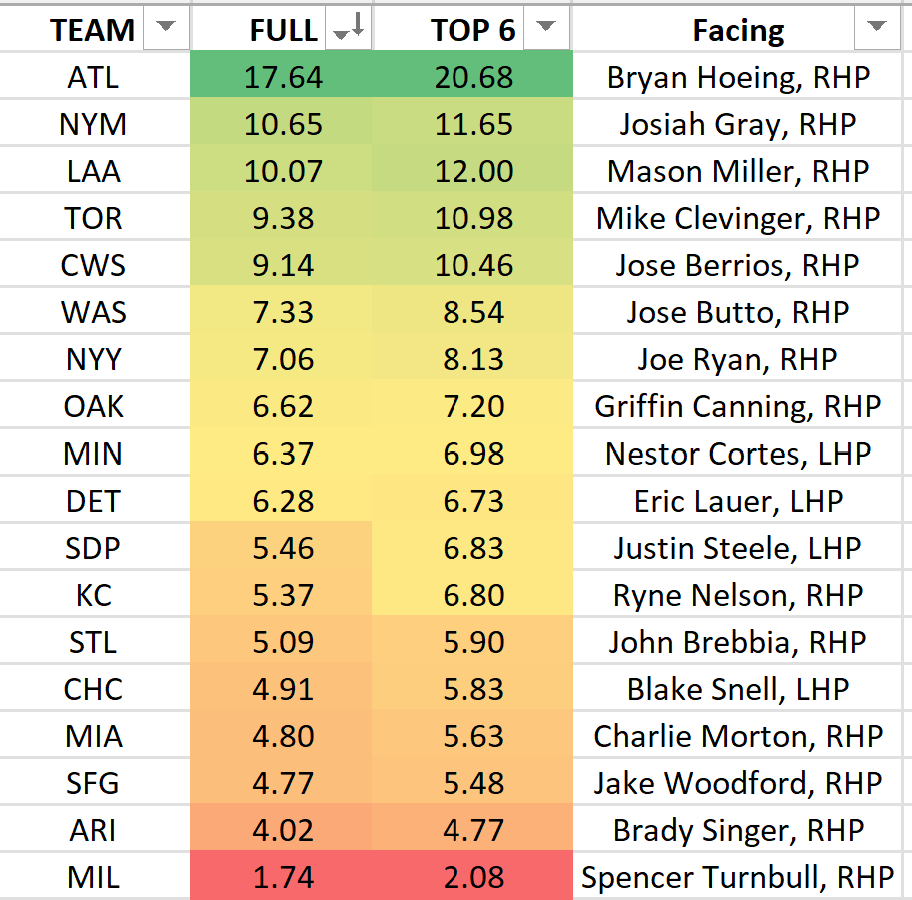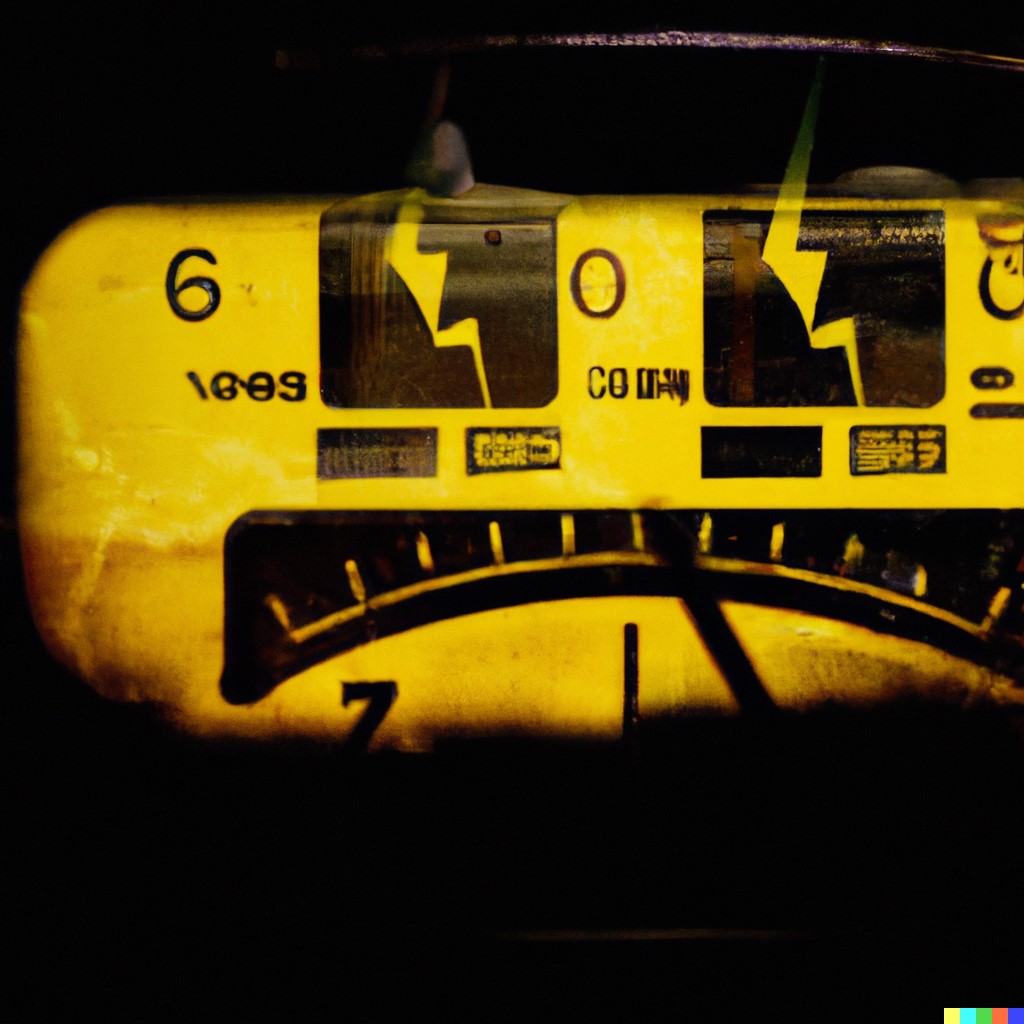The Tuesday nine-game main slate on DraftKings and FanDuel is showing a ton of power on the top end of the board, with several of the league’s hardest-hitting teams in play against some lower-end starters, with the exception of the outrageously talented Mason Miller, who may give up some individual power but also projects for another strong outing against the Angels. Outside of the elite rookie hurler, there are several targetable starters, with Josiah Gray once again contributing to one of the highest scores on the board, despite some recent improvement signaled by not giving up three home runs a game over his recent starts. Regardless of those possible upgrades, the Mets look like a dynamite opportunity for power this evening. A broad spread of both bats and pitching options on a deep slate for both seems like the approach to this one. A short sample in the Major and some AAA troubles with power have the Braves at the top of the board against rookie hurler Bryan Hoeing, even if the data is somewhat skewed, Atlanta is a strong target with what is probably baseball’s best offense.
Main Slate Power Index – 4/25/23 – DraftKings & FanDuel Main Slates
The power index represents a team’s opportunity for home run upside in the matchup against the scheduled starting pitcher. This is not a direct guideline for stacking, but it can be utilized to determine the most likely sources of power-based contact, hitters who are not homering are frequently hitting doubles and driving in runs, and providing valuable MLB DFS scoring. The “Full” column is the average of our home run opportunity score for each player in the lineup from 1-9, while the “Top 6” column averages only hitters 1-6, where teams typically place their biggest bats.

Washington starter Josiah Gray still has plenty of bad in his ledger to outweigh the recent starts in which he has been less vulnerable to home runs. The small sample could be a sign of some improvement in a young pitcher who is otherwise a well-regarded arm, or it could be a statistical blip. Gray does seem to be throwing his fastball less frequently, the pitch was typically pounded, while his breaking stuff is more effective at limiting power, but his strikeout totals have dipped for it. For lack of being able to determine which of those possibilities is the case, we have to default to the larger sample and assume that Gray is a target for the loaded Mets lineup on this slate. The righty has made four starts and given up four home runs so far this season, but three of those came in his first outing against the power-packed Braves. He pitched six innings of one-run ball in Colorado then 5.2 against the Angels, with just two runs allowed but giving up the fourth home run, and then had a five-inning start against the Orioles that saw him strike out just three while walking four, but he did not give up the long ball and was charged with only one earned run. Overall, Gray is sitting at a 5.14 xFIP in 21.2 innings with a 17% strikeout rate and a 9.6% walk rate, but he has kept hard hits to a fantastic 28.4% with just 84.1 mph of average exit velocity. If Gray gets through this Mets lineup a few times without giving up much in the way of power or premium contact it will be a noteworthy landmark on his ascent from the cellar. The Mets have a terrific lineup for sequencing, on-base ability, run creation, and power. The team’s leadoff man, Brandon Nimmo, has created runs 70% above average while slashing .250/.455/.500 with a .150 ISO over 100 plate appearances. Nimmo is more of a correlation piece, but the lefty can get into one for a home rnu at times, he hit 16 in 673 plate appearances last year. Starling Marte is similarly toolsy with multiple skillsets for mid-range power and blazing speed to create MLB DFS scoring. Marte has hit one home run and is slashing just .239/.333/.338 but he has stolen seven bases and is a strong option most nights, his below-par WRC+ will climb in short order. Francisco Lindor is second on the team with a 13.76 in tonight’s home run model. The shortstop has hit four long balls on the season and has a .244 ISO to go with his 123 WRC+. Despite slashing .221/.333/.465, Lindor has been a strong contributor all season. Pete Alonso leads the team with a whopping 20.92 in the home run model, better than doubling up our “magic number.” The slugging first baseman already has 10 home runs on the season, which was already more than any Met had ever hit in April in their history. Jeff McNeill is more of a slap-hitting correlation piece, he has one home run and a .111 ISO this year and hit nine homers with a .128 ISO last year. Mark Canha offers mid-range pop, he has two home runs on the board and lands at an 8.88 in the home run model today. Lefty Daniel Vogelbach is another player over the magic number with his 11.75 in the home run model. Vogelbach is a platoon specialist who has seen 51 plate appearances and hit one home run with a .125 ISO so far this year, but he had 18 homers in 461 tries while posting a .194 ISO last year. Rookie Brett Baty is showing a nice mark for power at a 9.75, he has yet to homer in his 22 plate appearances so far this year, he had two in 42 tries in a cup of coffee last year. Since his call-up, the prized prospect is slashing .238/.273/.238 with a .000 ISO and a 49 WRC+, he will get in gear soon enough. Tomas Nido is a defensive catcher who is not an overly strong asset at the plate for MLB DFS.
The Braves entire top-6 is pulling an average of double our magic number in the home run model, bolstered by the massive scores for the top three hitters. Ronald Acuna Jr., Matt Olson, and Austin Riley are all pulling in better than a 20 in the model, with Olson leading the way at 27.44, this is the strongest group home run spot we have seen to this point in the season. Acuna has hit three home runs and has a 167 WRC+, Olson has six homers on the board and a 149 WRC+, and Riley checks in with five home runs and a 131 WRC+. The excellent trio is great for MLB DFS even when they are not hitting the ball over the wall. Adding the balance of this team to the mix is unfair to the pitcher, Sean Murphy has more power than any catcher in baseball. He has hit six home runs in his 82 plate appearances this year and is slashing .277/.427/.662 with a .385 ISO and a 187 WRC+, Murphy is an everyday player who can be in lineups for MLB DFS regardless of positional requirements. Eddie Rosario got on the board last night, he now has two home runs and a .145 ISO for the season. Ozzie Albies is a power hitting second baseman who is too cheap at $4,300/$3,100, the price on the blue site is particularly low for a player with Albies’ skillset in a matchup like this. Vaughn Grissom has been a contributor since coming up, but his WRC+ sits well below average at 71 and he has no homers in the tiny 35 plate appearances sample. Sam Hilliard has been another fixture in this space since he stepped in for Michael Harris earlier in the season. Hilliard hit another two home runs and stole his fourth base of the season last night, he has three homers and is slashing .333/.412/.622 with a 176 WRC+ and a .289 ISO over his 51 plate appearances. Hilliard is playable for cheap prices when he is in the lineup, even after Harris returns it seems like the lefty has earned an ongoing backup job. Kevin Pillar is not much at the plate at this point in his career, but he has managed one homer in 40 plate appearances. The Braves join the Mets as potential NL East smash spots for power and individual upside tonight, stringing together some sequencing and run-scoring in between the likely home runs will put full stacks on board, and both teams are very good at doing those things when they are not hitting home runs.
Follow Us on Twitter. Join us in Discord.




